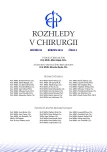Secondary angiosarcoma of the abdominal wall after adjuvant radiotherapy in a patient with uterine carcinoma – a case report
Authors:
A. Zatloukal 1; M. Lerch 1,2; P. Zonča 1,2
Authors‘ workplace:
Chirurgická klinika FN Ostrava
přednosta: doc. MUDr. P. Zonča, Ph. D., FRCS
1; Katedra chirurgických oborů LF, Ostravská univerzita v Ostravě
vedoucí katedry: doc. MUDr. P. Vávra, Ph. D.
2
Published in:
Rozhl. Chir., 2016, roč. 95, č. 3, s. 131-133.
Category:
Case Report
Overview
Introduction:
Adjuvant radiotherapy is an integral part of the current treatment of many malignant tumours. However, this mode of treatment does not provide only benefits in the sense of lowering the risks of recurrence, but it is also associated with many undesirable side effects, from which one of the most serious is the development of secondary malignancies.
Case report:
The author describes a case report of 77 years old woman who underwent hysterectomy with bilateral adnexectomy and pelvic lymphadenectomy for uterine carcinoma pT1bN0M0, G1 in 2005. Adjuvant external radiotherapy with the dose 45Gy and brachytherapy 3x4Gy followed. Subsequently the patient was followed at the department of gynecology, which referred her in January 2015 with a quickly growing tumour of the skin and subdermal tissue in the hypogastric area, where previous radiation had been applied. Its excision was indicated with the diagnosis of suspected uterine carcinoma metastasis, but subsequent histological evaluation confirmed angiosarcoma. Despite negative resection margins the tumour quickly recurred and disseminated.
Conclusion:
Angiosarcoma as a side effect of irradiation is described increasingly more often nowadays. The vast majority of cases are related to the treatment of breast carcinoma. Its prognosis is very poor and therapeutic possibilities are limited. Surgical excision with negative margins remains the mainstay of the treatment. It is necessary to keep this diagnosis in mind and patients undergoing radiation treatment should be followed over a long period.
Key words:
angiosarcoma
Sources
1. Young RJ, Brown NJ, Reed MW, et al. Angiosarcoma. Lancet Oncol 2010;11:983−91.
2. Virtanen A, Pukkala E, Auvinen A. Angiosarcoma after radiotherapy: a cohort study of 332 163 Finnish cancer patiens. Br J Cancer 2007;97:115−7.
3. Sanz C, Moreno F, Armas A, et al. Groin angiosarcoma following radiotherapy for vulvar cancer. Gynecol Oncol 2005;9:677−80.
4. D’Angelo SP, Antonescu CR, Kuk D, et al. High-risk features in radiation-associated breast angiosarcomas. Br J Cancer 2013;109:2340–6.
5. Fanta J, Vašina T. Segmentální duodenektomie (D3,D4) pro angiosarkom. Rozhl Chir 2012;91:388−92.
6. Pawlik TM, Paulino AF, McGinn CJ, et al. Cutaneous angiosarcoma of the scalp: a multidisciplinary approach. Cancer 2003;98:1716−26.
7. Toro JR, Travis LB, Wu HJ, et al. Incidence patterns of soft tissue sarcomas,regardless of primary site,in the surveillance,epidemiology and end results program 1978−2001: An analysis of 26,758 cases. Int J Cancer 2006;119:2922−30.
8. The ESMO/European Sarcoma Network Working Group. Soft tissue and visceral sarcomas: ESMO Practice Guidelines. Ann Oncol 2014;25(suppl 3):iii102-iii112.
9. Mark RJ, Poen JC, Tran LM, et al. Angiosarcoma. A report of 67 patients and a review of the literature. Cancer 1996;77:2400−6.
10. Schottenfeld D, Fraumeni J. Cancer. Epidemiology and prevention. 3rd ed. New York, Oxford University Press 2006.
11. Brenn T, Fletcher CD. Postradiation vascular proliferation: an increasing problem. Histopathology 2006;48:106−14.
12. Thijssens KM, van Ginkel RJ, Suurmeijer AJ, et al. Radiation–induced sarcoma: a challenge for the surgeon. Ann Surg Oncol 2005;12:237−45.
13. Riad S, Biau D, Holt GE, et al. The clinical and functional outcome for patients with radiation-induced soft tissue sarcoma. Cancer 2012;118:2682–92.
14. Huang J, Mackillop WJ. Increased risk of soft tissue sarcoma after radiotherapy in women with breast carcinoma. Cancer 2001;92:172−80.
15. Pearlstone DB, Janian NA, Feig BW, et al. Re-resection with brachytherapy for locally recurrent soft tissue sarcoma arising in a previously radiated field. Cancer J Sci Am 1999;5:26−33.
16. Fata F, O’Reilly E, Ilson D, et al. Paclitaxel in the treatment of patients with angiosarcoma of the scalp or face. Cancer 1999;86:2034–7.
17. Italiano A, Cioffi A, Penel N, et al. Comparison of doxorubicin and weekly paclitaxel efficacy in metastatic angiosarcomas. Cancer 2012;118:3330–6.
18. Chen KT, Hoffman KD, Hendricks EJ. Angiosarcoma following therapeutic irradiation. Cancer 1979;44:2044−8.
19. Kiyohara T, Kumakiri M, Kobavashi H, et al. Spindle cell angiosarcoma following irradiation therapy for cervical carcinoma. J Cutan Pathol 2002;29:96−100.
20. Caldwell JB, Ryan MT, Benson PM, et al. Cutaneous angiosarcoma arising in the radiation site of a congenital hemangioma. J Am Acad Dermatol 1995;33:865−70.
21. Coffin CM, Vietti TJ, Land VJ, et al. Cutaneous angiosarcoma as a second malignant neoplasm after peripheral primitive neuroectodermal tumor. Med Pediatr Oncol 1992;20:352−6.
22. Zedníková I, Šafránek J, Hlaváčková M, et al. Sarkom hrudní stěny po ozáření pro karcinom prsu – kazuistika. Rozhl Chir 2014;93:396–400.
23. Vojtíšek R, Kinkor Z, Fínek J. Sekundární angiosarkomy po konzervativní léčbě nádorů prsu. Klin Onkol 2011;24:382−8.
24. Kajo K, Lúčan J, Macháleková K, et al. Kožný angiosarkom vzniknutý po chirurgickom konzervatívnom zákroku a následnej rádioterapii pre karcinom prsníka – kazuistika. Čes slov Patol 2007;2:59−63.
Labels
Surgery Orthopaedics Trauma surgeryArticle was published in
Perspectives in Surgery

2016 Issue 3
Most read in this issue
- Atypical, extra pancreatic pseudocyst of the pancreas
- Optimal timing of laparoscopic cholecystectomy in treatment of acute cholecystitis
- Lumbar sympathectomy − literature review over the past 15 years
- Giant aneurysm of the abdominal aorta and iliac arteries
